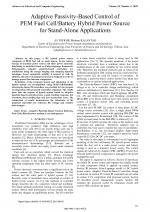| 4/2010 - 18 |
Adaptive Passivity-Based Control of PEM Fuel Cell/Battery Hybrid Power Source for Stand-Alone ApplicationsTOFIGHI, A. |
| View the paper record and citations in |
| Click to see author's profile in |
| Download PDF |
Author keywords
adaptive passivity-based control, batteries, fuel cells, hybrid power systems, load management
References keywords
control(29), power(27), fuel(19), cell(17), energy(14), electronics(12), passivity(10), modeling(10), hybrid(10), dynamic(9)
Blue keywords are present in both the references section and the paper title.
About this article
Date of Publication: 2010-11-30
Volume 10, Issue 4, Year 2010, On page(s): 111 - 120
ISSN: 1582-7445, e-ISSN: 1844-7600
Digital Object Identifier: 10.4316/AECE.2010.04018
Web of Science Accession Number: 000284782700018
SCOPUS ID: 78649707648
Abstract
In this paper, a DC hybrid power source composed of PEM fuel cell as main source, Li-ion battery storage as transient power source and their power electronic interfacing is modelled based on Euler-Lagrange framework. Subsequently, adaptive passivity-based controllers are synthesized using the energy shaping and damping injection technique. Local asymptotic stability is insured as well. In addition, the power management system is designed in order to manage power flow between components. Evaluation of the proposed system and simulation of the hybrid system are accomplished using MATLAB/Simulink. Afterwards, linear PI controllers are provided for the purpose of comparison with proposed controllers responses. The results show that the outputs of hybrid system based on adaptive passivity-based controllers have a good tracking response, low overshoot, short settling time and zero steady-state error. The comparison of results demonstrates the robustness of the proposed controllers for reference DC voltage and resistive load changes. |
| References | | | Cited By |
Web of Science® Times Cited: 6 [View]
View record in Web of Science® [View]
View Related Records® [View]
Updated 2 days ago
SCOPUS® Times Cited: 11
View record in SCOPUS® [Free preview]
View citations in SCOPUS® [Free preview]
[1] Behavioral Model of Photovoltaic Panel in Simulink, ZAPLATILEK, K., LEUCHTER, J., Advances in Electrical and Computer Engineering, ISSN 1582-7445, Issue 4, Volume 11, 2011.
Digital Object Identifier: 10.4316/AECE.2011.04013 [CrossRef] [Full text]
[2] Adaptive Passivity-Based Control of a Photovoltaic/Battery Hybrid Power Source via Algebraic Parameter Identification, Mojallizadeh, Mohammad Rasool, Badamchizadeh, Mohammad Ali, IEEE Journal of Photovoltaics, ISSN 2156-3381, Issue 2, Volume 6, 2016.
Digital Object Identifier: 10.1109/JPHOTOV.2016.2514715 [CrossRef]
[3] Optimized Solar Energy Power Supply for Remote Wireless Sensors Based on IEEE 802.15.4 Standard, Krejcar, Ondrej, Mahdal, Miroslav, International Journal of Photoenergy, ISSN 1110-662X, Issue , 2012.
Digital Object Identifier: 10.1155/2012/305102 [CrossRef]
[4] Modelling and Simulation of Fuel Cell Dynamics for Electrical Energy Usage of Hercules Airplanes, Radmanesh, Hamid, Heidari Yazdi, Seyed Saeid, Gharehpetian, G. B., Fathi, S. H., The Scientific World Journal, ISSN 2356-6140, Issue , 2014.
Digital Object Identifier: 10.1155/2014/593121 [CrossRef]
[5] Control alghorithm of fuel cell hybrid source based on the flatness propriety, Benaouadj, M., Aboubou, A., Ayad, M. Y., Becherif, M., Bahri, M., 3rd International Symposium on Environmental Friendly Energies and Applications (EFEA), ISBN 978-1-4799-7517-4, 2014.
Digital Object Identifier: 10.1109/EFEA.2014.7059964 [CrossRef]
[6] Energy management of fuel cell/ supercapacitor hybrid power sources based on the flatness control, Saadi, R., Benaouadj, M., Kraa, O., Becherif, M., Ayad, M.Y., Aboubou, A., Bahri, M., Haddi, A., 4th International Conference on Power Engineering, Energy and Electrical Drives, ISBN 978-1-4673-6392-1, 2013.
Digital Object Identifier: 10.1109/PowerEng.2013.6635593 [CrossRef]
Disclaimer: All information displayed above was retrieved by using remote connections to respective databases. For the best user experience, we update all data by using background processes, and use caches in order to reduce the load on the servers we retrieve the information from. As we have no control on the availability of the database servers and sometimes the Internet connectivity may be affected, we do not guarantee the information is correct or complete. For the most accurate data, please always consult the database sites directly. Some external links require authentication or an institutional subscription.
Web of Science® is a registered trademark of Clarivate Analytics, Scopus® is a registered trademark of Elsevier B.V., other product names, company names, brand names, trademarks and logos are the property of their respective owners.
Faculty of Electrical Engineering and Computer Science
Stefan cel Mare University of Suceava, Romania
All rights reserved: Advances in Electrical and Computer Engineering is a registered trademark of the Stefan cel Mare University of Suceava. No part of this publication may be reproduced, stored in a retrieval system, photocopied, recorded or archived, without the written permission from the Editor. When authors submit their papers for publication, they agree that the copyright for their article be transferred to the Faculty of Electrical Engineering and Computer Science, Stefan cel Mare University of Suceava, Romania, if and only if the articles are accepted for publication. The copyright covers the exclusive rights to reproduce and distribute the article, including reprints and translations.
Permission for other use: The copyright owner's consent does not extend to copying for general distribution, for promotion, for creating new works, or for resale. Specific written permission must be obtained from the Editor for such copying. Direct linking to files hosted on this website is strictly prohibited.
Disclaimer: Whilst every effort is made by the publishers and editorial board to see that no inaccurate or misleading data, opinions or statements appear in this journal, they wish to make it clear that all information and opinions formulated in the articles, as well as linguistic accuracy, are the sole responsibility of the author.





